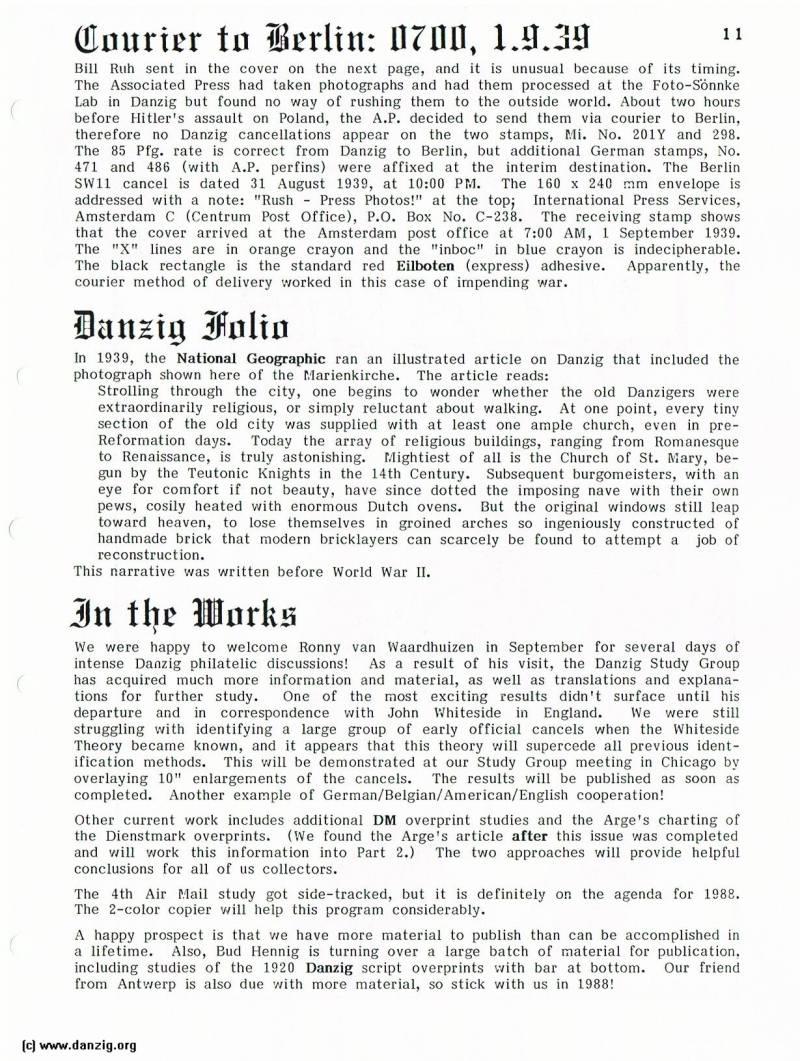
Courier to Berlin: 0700, 1.9.39
Bill Ruh sent in the cover on the next page, and it is unusual because of its timing. The Associated Press had taken photographs and had them processed at the Foto-Sónnke Lab in Danzig but found no way of rushing them to the outside world. About two hours before Flitler’s assault on Poland, the A.P. decided to send them via courier to Berlin, therefore no Danzig cancellations appear on the two stamps, Mi. No. 201Y and 298. The 85 Pfg. rate is correct from Danzig to Berlin, but additional German stamps, No. 471 and 486 (with A.P. perfins) were affixed at the interim destination. The Berlin SW11 cancel is dated 31 August 1939, at 10:00 PM. The 160 x 240 mm envelope is addressed with a note: “Rush - Press Photos!” at the top International Press Services, Amsterdam C (Centrum Post Office), P.O. Box No. C—238. The receiving stamp shows that the cover arrived at the Amsterdam post office at 7:00 AM, 1 September 1939. The “X” lines are in orange crayon and the “inboc” in blue crayon is indecipherable. The black rectangle is the standard red Eilboten (express) adhesive. Apparently, the courier method of delivery worked in this case of impending war.
Danzig folio
In 1939, the National Geographic ran an illustrated article on Danzig that included the photograph shown here of the £larienkirche. The article reads:
Strolling through the city, one begins to wonder whether the old Danzigers were extraordinarily religious, or simply reluctant about walking. At one point, every tiny section of the old city was supplied with at least one ample church, even in preR eformation days. Today the array of religious buildings, ranging from Romanesque to Renaissance, is truly astonishing. Mightiest of all is the Church of St. Mary, beg un by the Teutonic Knights in the 14th Century. Subsequent burgomeisters, with an eye for comfort if not beauty, have since dotted the imposing nave with their own pews, cosily heated with enormous Dutch ovens. But the original windows still leap toward heaven, to lose themselves in groined arches so ingeniously constructed of handmade brick that modern bricklayers can scarcely be found to attempt a job of reconstruction.
This narrative was written before World War II.
In the works
We were happy to welcome Ronny van Vaardhuizen in September for several days of intense Danzig philatelic discussions! As a result of his visit, the Danzig Study Group has acquired much more information and material, as well as translations and explanat ions for further study. One of the most exciting results didn’t surface until his departure and in correspondence with John Whiteside in England. We were still struggling with identifying a large group of early official cancels when the Whiteside Theory became known, and it appears that this theory will supercede all previous identi fication methods. This will be demonstrated at our Study Group meeting in Chicago by overlaying 10” enlargements of the cancels. The results will be published as soon as completed. Another example of German/Belgian/American/English cooperation!
Other current work includes additional DM overprint studies and the Arge’s charting of the Dienstmark overprints. (‘.Ve found the Arge’s article after this issue was completed and will work this information into Part 2.) The two approaches will provide helpful conclusions for all of us collectors.
The 4th Air Mail study got side—tracked, but it is definitely on the agenda for 1988. The 2—color copier will help this program considerably.
A happy prospect is that we have more material to publish than can be accomplished in a lifetime. Also, Bud Hennig is turning over a large batch of material for publication. including studies of the 1920 Danzig script overprints with bar at bottom. Our friend from Antwerp is also due with more material, so stick with us in 1988!
Danzig Report Vol. 1 - Nr. 57 - October - November - December - 1987, Page 11.
Hits: 3105
Added: 23/06/2015
Copyright: 2025 Danzig.org

